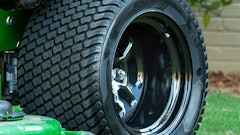
When it comes to hauling heavy equipment and materials, a reliable open trailer is the backbone of any lawn care and landscape professional’s operation. For those in the green industry, where getting the job done quickly and safely is essential, knowing how to properly load, connect and tow these trailers can make a big difference. It can save you time, protect your equipment and keep you safe on the road.
A trailer essentially allows you to take your entire business with you anywhere you go. Whether you're transporting mowers, mulch or a full load of landscaping equipment, these loading and towing tips and best practices will help your crew confidently hit the road and focus on delivering top-notch service to your clients.
Knowing your limits
Before loading up, make sure you know your trailer’s gross vehicle weight rating (GVWR) to determine the maximum weight allowed (the combination of both your trailer and the cargo you wish to tow). Look for the GVWR on the vehicle identification number label of your trailer.
Next, be aware of the towing capacity of your pulling vehicle. This is the maximum weight it can safely tow, which includes the weight of the trailer and its cargo. Understanding the GVWR of the trailer and the towing capacity of your pulling vehicle ensures you select the right trailer and maintain safe towing practices.
Other helpful things to know include:
- Trailer weight: The weight of a fully assembled, empty trailer.
- Payload capacity: The total weight capacity of a trailer. To determine payload capacity, subtract the weight of your trailer from the trailer GVWR.
- Tongue weight: This is the amount of the trailer’s weight that is transferred to your tow vehicle through the trailer tongue or gooseneck. A general rule of thumb is that 20-25% of a trailer’s total weight plus its cargo should be on the tongue of the trailer.
Pack it up, pack it in
Once you know your weight limits, you’re ready to start loading your open trailer. Keep in mind that your open trailer should be loaded heavier in the front of the deck—this should be about 60% of your cargo weight.
Remember to pack your cargo closely and firmly, using tie downs or other tensioning devices to keep cargo secure. No small items should be loaded above the height of the sides of the trailer, even if you are only transporting something a short distance.
Beyond those basics, there are some additional loading tips for open trailers to keep in mind.
- Fixed loads: A fixed load includes mowers, palletized materials and skid-steer loaders or other similar equipment. When you have this type of load, if it needs to be carried or dumped, be sure to do so evenly throughout the trailer.
- Rear loading equipment: Remember to lower your rear stabilizers if your trailer is equipped, or place blocking under the rear of your trailer to help keep the front of the trailer in place during loading. Make sure your trailer’s doors/gates are securely opened and put the ramps into place. Then, load the trailer as you would any other, making sure the cargo weight is distributed appropriately.
- Side loading: If your trailer is equipped with a fold-down side, unlatch and open the side panel, and then load cargo, such as pallets. Be sure to follow the proper steps for securing your cargo to the trailer and make sure to raise and lock the side panels before towing your trailer. Failure to do so will create a driving hazard and could lead to serious injury or worse.
- Loading bulk materials in a dump trailer: If you will be hauling bulk materials, be sure to tell the loader operator your trailer’s payload capacity so he or she will have an approximate weight of the materials to be loaded. If you are uncertain about the weight of the materials to be loaded, always err on the side of caution and load a small amount and then weigh your trailer. Evenly distribute the load in the trailer across the width and length and cover with a tarp if any materials might blow out of the trailer when traveling. If you notice your trailer is overloaded, do not attempt to raise the dump body. Use the necessary equipment to remove excess weight or do it by hand.
Towing safety essentials
Once your trailer has been properly loaded, be sure to follow these general precautions for towing safety, such as:
- Avoid distracted driving.
- Do not drive when you are sleepy or fatigued.
- Maintain a speed of 55 miles per hour or less.
- Anticipate stops, brake early, and maintain a safe distance from the car in front of you.
- Slow down before you start driving downhill.
- Do not ride your brakes while going downhill.
- Do not use cruise control or overdrive while towing a trailer.
- Avoid sharp turns.
- Ease off the gas pedal and slow your speed to 25 miles per hour in the event that a wheel goes off a paved road, then gradually steer your vehicle and trailer back onto the road.
- Make routine stops to check and retighten lug nuts, check air pressure, and that the coupler, safety chains and cargo are still secure.
Prioritizing safety
As always, consult with your owner’s manual or dealer for the most specific loading and towing instructions for your open trailer. By following safe loading and towing practices, you position your business for true long-term success—protecting both your crew and your bottom line.


























